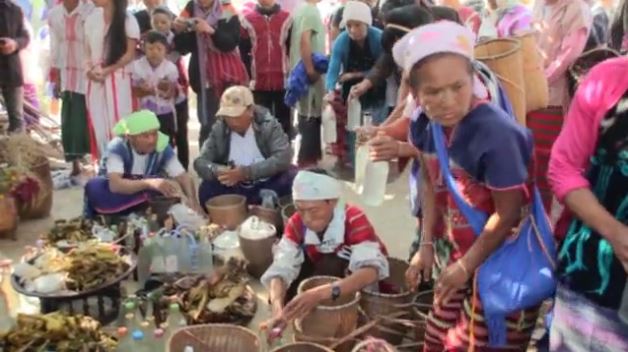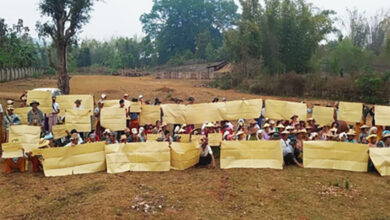Karen Villagers Breathe Life Into Their Rice-Tying Ritual To Summon The Rice Spirits

Traditionally the Karen people believe nature has its own spirits. The Karen people place great importance on these spirits and depend on them for their wellbeing. These spirits live in and are the caretakers of the mountains, forests, rivers and plants. The spirits are also in food including rice.
Today many of these traditional beliefs are gradually becoming less practiced, many Karen communities, especially in rural areas, hold events maintaining their traditional beliefs central to their culture.
The villagers of Htee Wah Blaw in Myawaddy Township are one of these communities and they have joined together with its neighboring village, P’naw Klei Kee, to perform a ceremony to summon the rice spirits after harvest. The ritual was held to call for the rice spirits to come back to make the next harvest bountiful.
The rice ceremony to call the spirits is an old Karen tradition, normally held during the first week of the New Year (January) and just after the rice harvest.
Pu Pah Kyar, a village elder is to lead the ceremony. He explains to Karen News that in the past, the rice had become endangered because local people failed to acknowledge, respect and care for its spirits.
“According to our elders, the reason rice crops fail is because Karen Animists forgot to care for them. The rice spirits were unhappy and disappeared until the local Animists searched for them and summoned them back. After local people “tie the rice” and make offerings to the spirits, their food production becomes prosperous once again.”
Pu Pah Kyar believes that future Karen generations have to care for the spirits.
“They need to keep the traditional rituals alive, so that the next generation will observe, witness, and practice them.”
Naw Mu Pweh, a villager from P’naw Klei Kee village explains to Karen News about how she was told to care for the rice.
“According to our elders, we have to preserve the rice crops that support our livelihoods. Just as we must nurture and care for our children to keep them healthy, we must nurture and care for the rice.”
Naw Mu Pweh shares the strong belief of her elders.
“If we continue to practice this ritual by making offerings to summon the spirits, just like we do for our own (human) spirits, the rice spirits will return and stay with us, and not vanish from among us.”
Despite the traditional rice ceremony being nominated as an annual event, this is only the second time that the ceremony to summon the spirits of the rice has been held in P’naw Klei Kee village.
Villagers said that more than 60-years of armed conflict, massive displacement and migration made it hard for villages to commemorate the spirits.
Naw San, a villager from Htee Wah Blaw village describes what is needed to prepare for the ceremony.
“We gather together a bottle of traditional Karen whiskey, boiled chicken, and the rice seeds that will be planted in the upcoming year. Each person has to bring 1kg of rice.”
Pu Pah Kyar, the village elder and ceremonial leader explains in more detail.
“Everyone brings food, including rice pastries, rice porridge, chicken and Karen whiskey to the ceremony. The leader and deputy [leader] each bring a bottle of whiskey and a chicken. Each household also brings a bottle of whiskey, a chicken, and their rice seeds and places them together.”
Pu Pah Kyar said that it is important that the ceremony is carried out in the traditional way by villages.
“Then people use a paddle, along with flowers, to “fan” the rice spirits back and forth, “fanning” to the south (Ma La Ka) three times, to the west three times, to the north (Hsa K’saw) three times, and to the east three times. Finally, they bang the edge of a winnowing tray and perform the invocation prayer to bring back the spirits.”
The ceremony to summon the rice spirits is a long held Karen tradition, and the ritual is held in accordance with Karen traditional practices. Pu Pah Kyar said that the ceremony now differs from what elders had done in the past.
“We are told by the elders that the Karen are the eldest brother, and that our traditions are good. Our traditional costumes include the red cotton shirt and sarong for men, a white dress for a single woman, and a red sarong and dark-blue blouse with beads at the bottom for a married woman. We perform the rice-tying ceremony while wearing our traditional clothing.”
Villagers stress that different religious beliefs are not a barrier to take part in the ritual, as it is important that all Karen people take part in the ceremony and work together.
Naw Mu Pweh participated at this year’s ceremony and said.
“Though we have different faiths, it is a good deed to perform [rice ceremony]. Karen Buddhists do not have a social taboo (against participating in the ceremony). Anyone willing to cooperate can join. There is no discrimination.”
Today, certain Karen traditions have almost disappeared from many villages, but Naw San is pleased that young Karen people in Htee Wah Blaw and P’naw Klei Kee villages are striving to keep their culture alive.
“As young people in the village are instructed by their parents, they gain greater knowledge and interest in maintaining their cultural traditions”
The Karen Student Network Group (KSNG), a Thai border based Karen student group that is involved in community and social works, supports the rice ritual by giving awards for Karen cultural performances, held in the evening of the event. Karen young people from overseas contributed financial support to help make the ceremony a reality.
Naw Pat Pay, a representative of the KSNG who took part at the ceremony spoke to Karen News about their group’s involvement.
“We came back to cooperate and observe how the ceremony is conducted. This is a symbol of our Karen traditions. Our aim is for the Karen people to maintain their Karen traditions so they do not disappear. Our hope is to revitalize our Karen traditional culture.”




